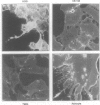Abstract
Rat oligodendrocytes spontaneously activate complement (C) and lack the C inhibitor CD59. As a consequence, rat oligodendrocytes are susceptible to lysis by autologous C in vitro. Expression of C inhibitors on human oligodendrocytes in vitro and other human glia has yet to be well characterized. We have previously shown expression at the mRNA level of the membrane inhibitors CD59, decay-accelerating factor (DAF; CD55) and membrane cofactor protein (MCP; CD46) in human astrocytes. We here examine the expression of membrane and secreted C inhibitors by the oligodendrocyte cell line, HOG. HOG cells abundantly expressed CD59, assessed at protein and mRNA level, and expressed DAF and MCP, albeit at a lower level. Expression of all three inhibitors was enhanced by incubation with interferon-gamma or with phorbol ester (PMA). Complement receptor type 1 (CR1; CD35) was neither expressed constitutively nor induced by cytokines. HOG also constitutively secreted C1-inhibitor, S-protein and clusterin. Factor H was secreted only after stimulation with cytokines. C4b binding protein was expressed at a very low level and was detected only at the mRNA level by reverse transcriptase-polymerase chain reaction (RT-PCR). For comparison, astrocyte expression of CD59, DAF, MCP and CR1 was confirmed at the mRNA and protein levels. HOG did not activate C spontaneously, as judged by the lack of deposition of C fragments, and were not lysed by C even after inhibition of CD59 and DAF using specific monoclonal antibodies.
Full text
PDF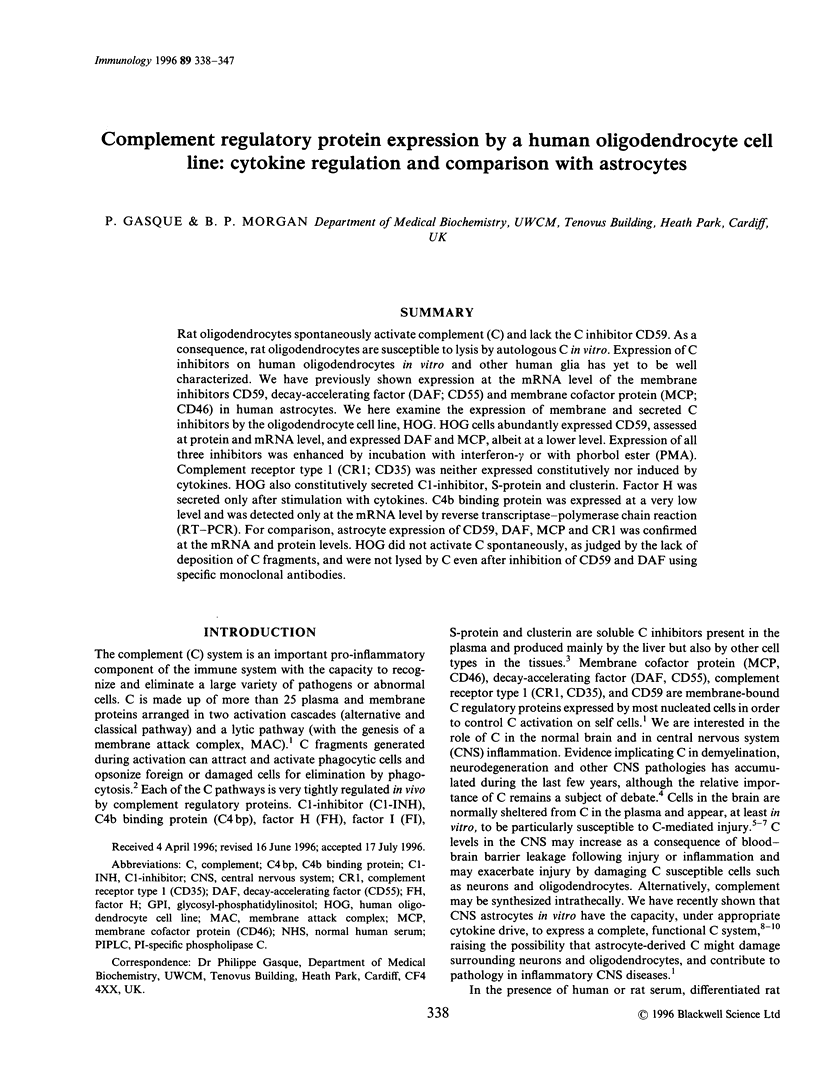
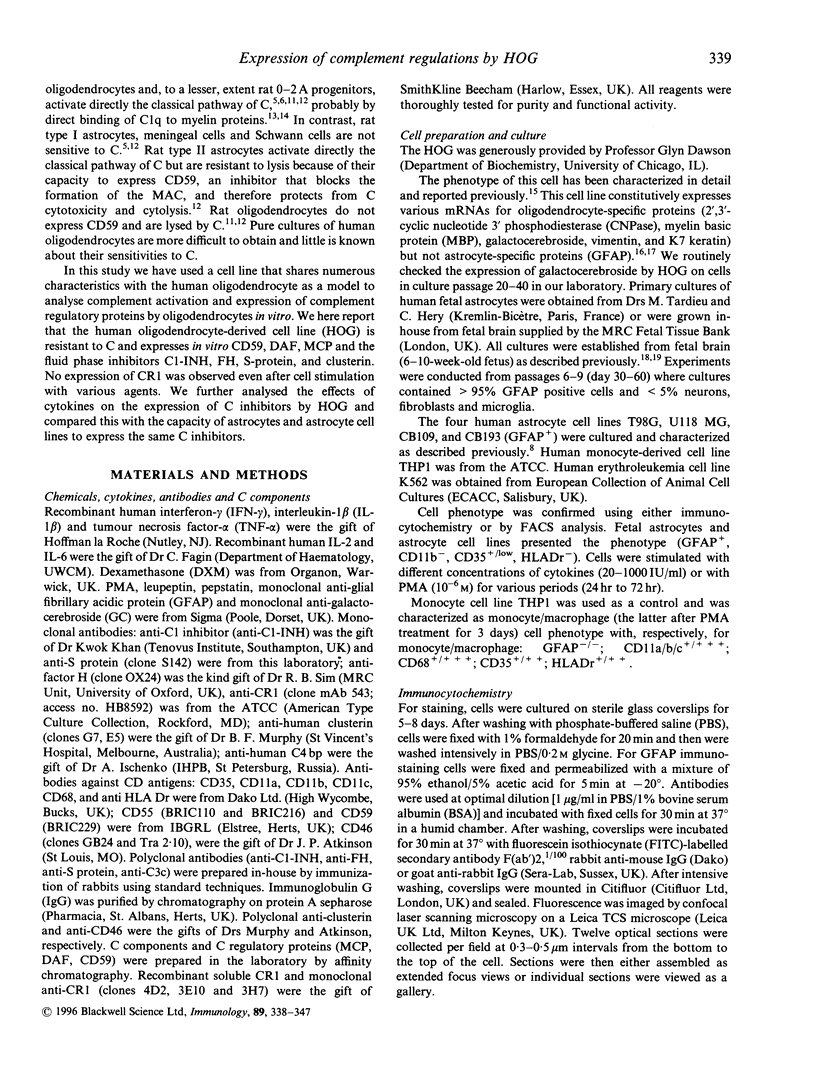
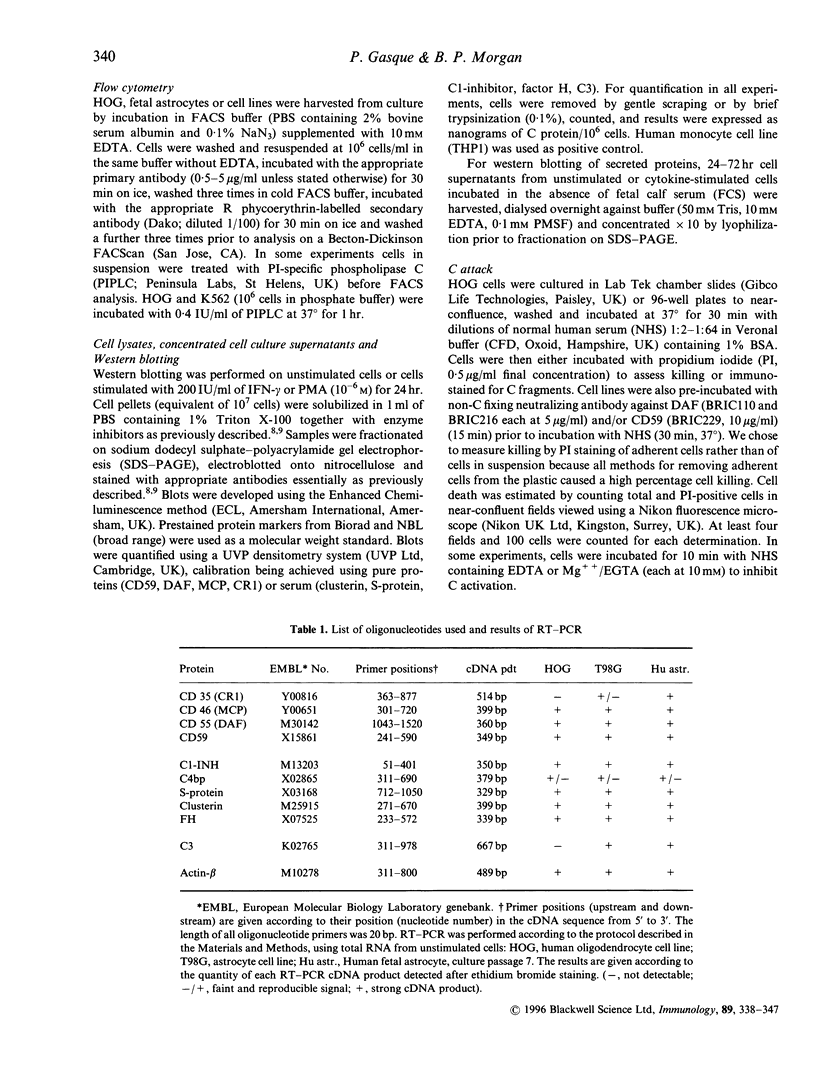
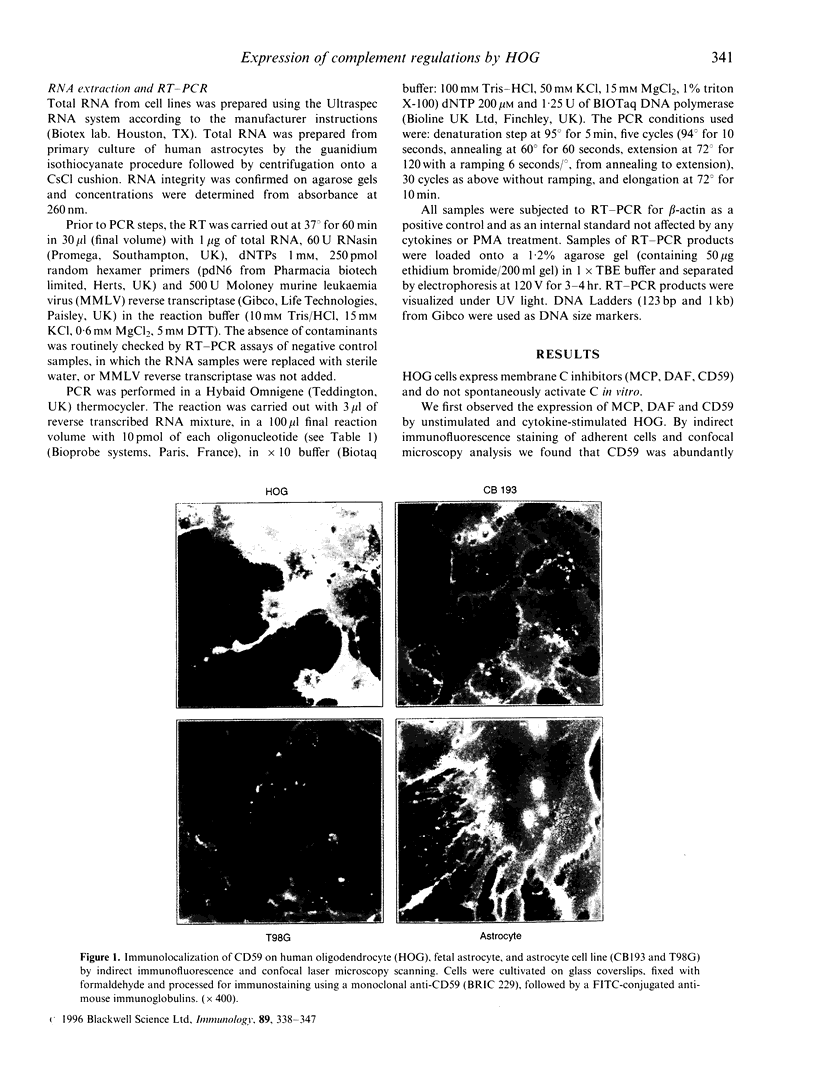
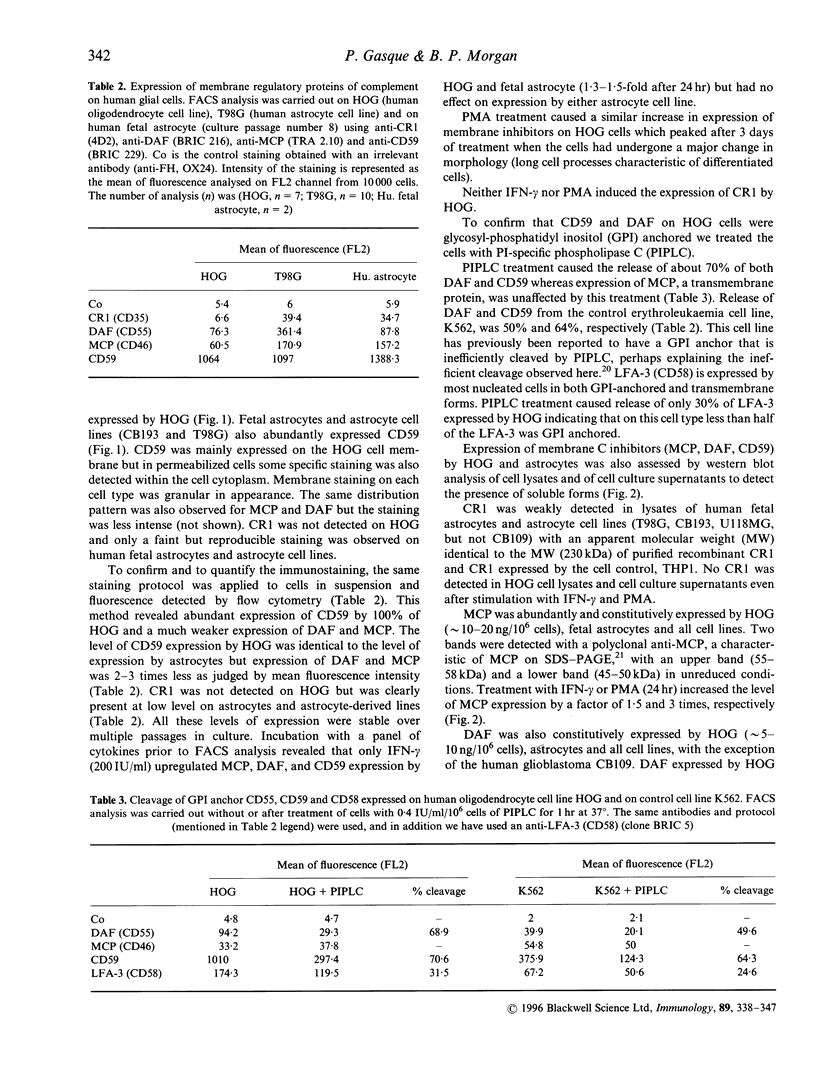
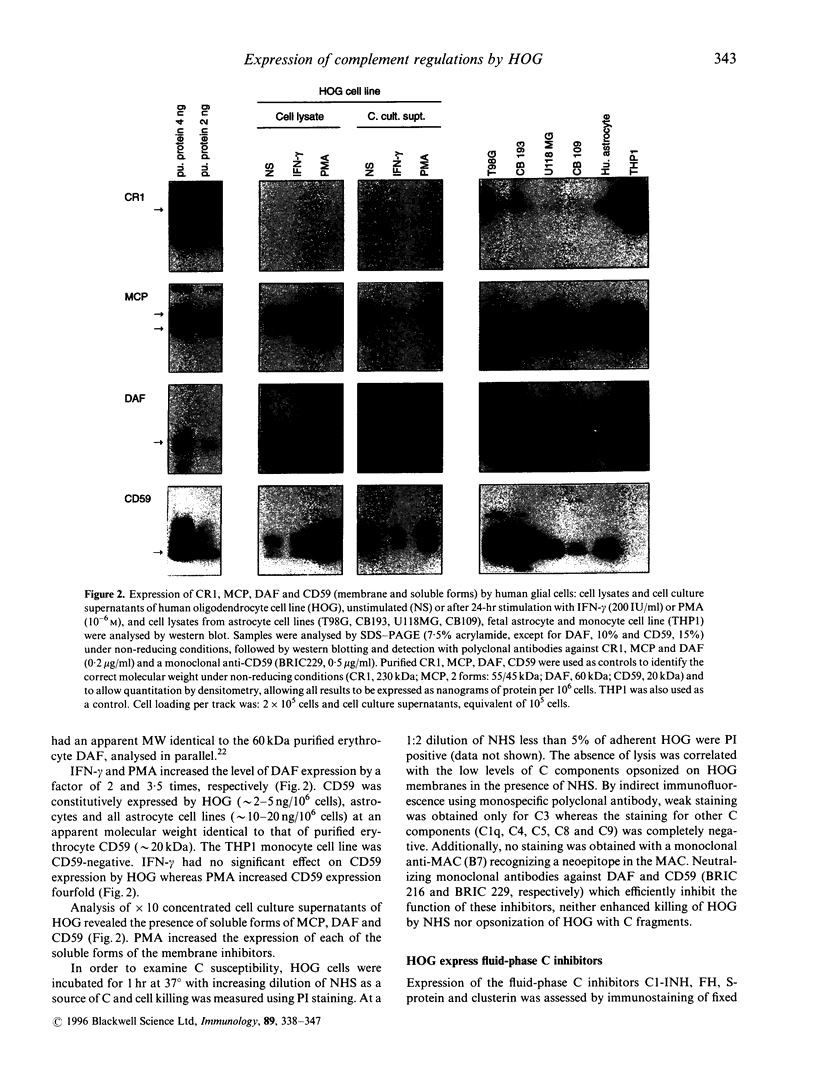
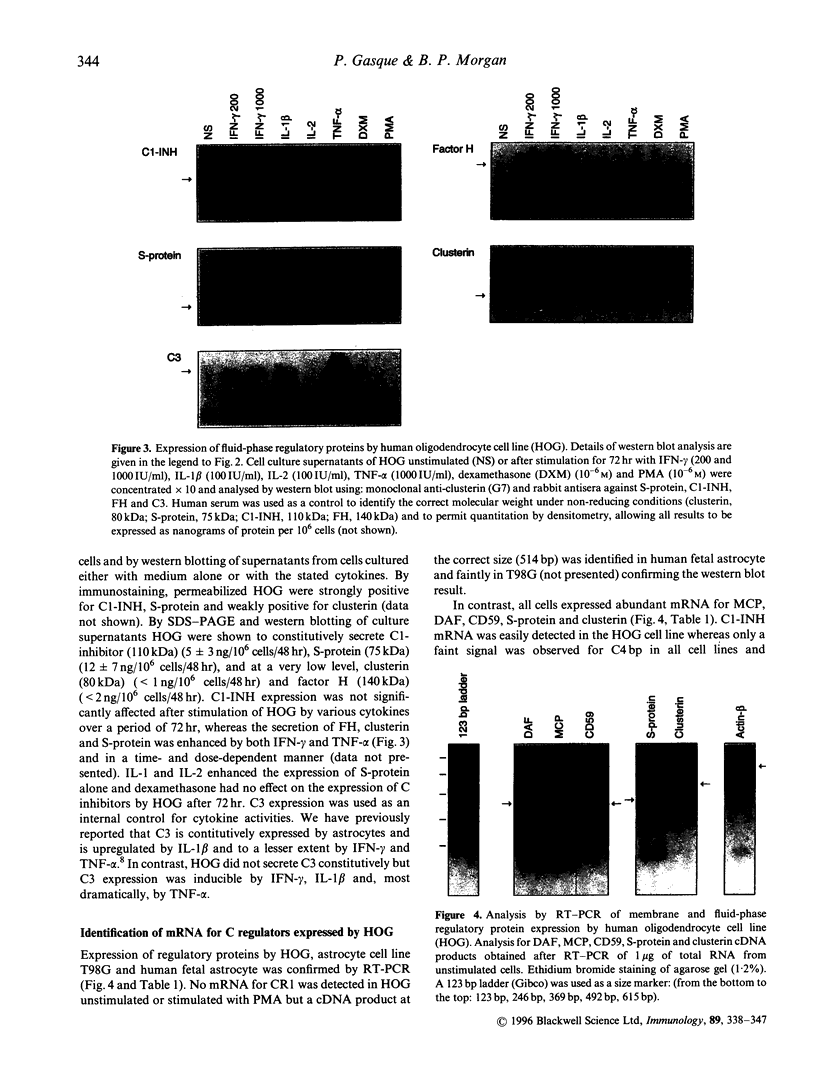
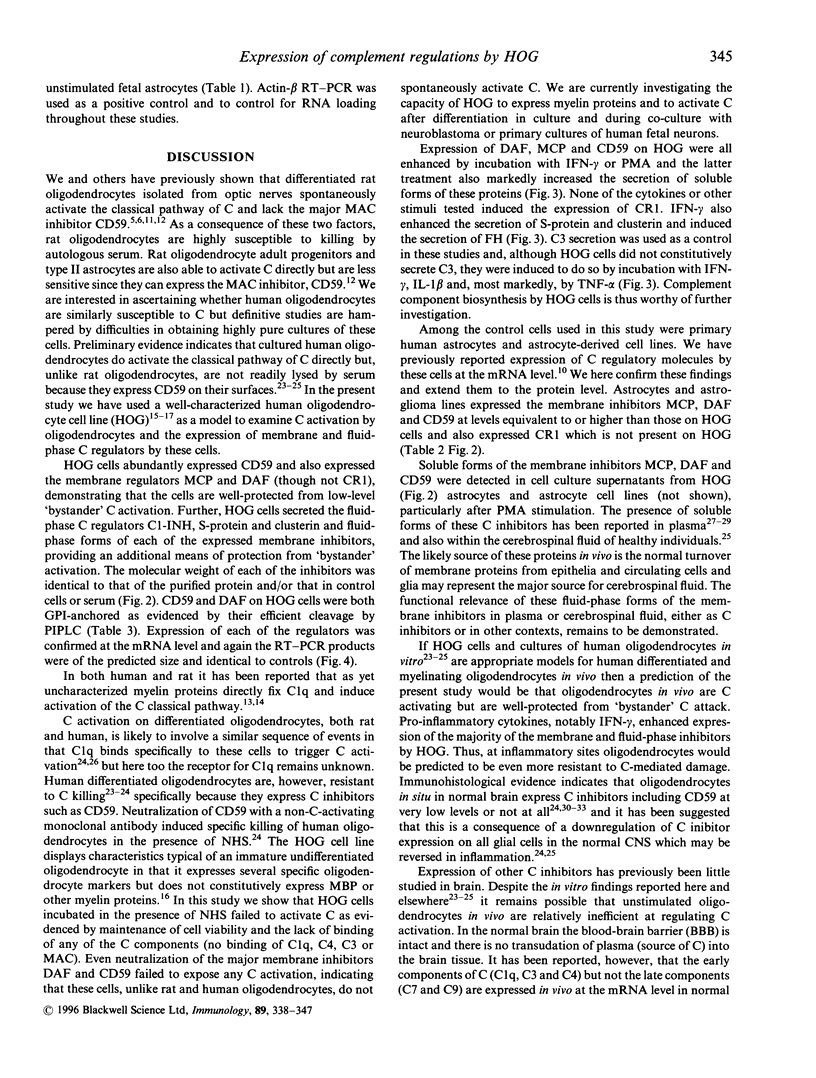
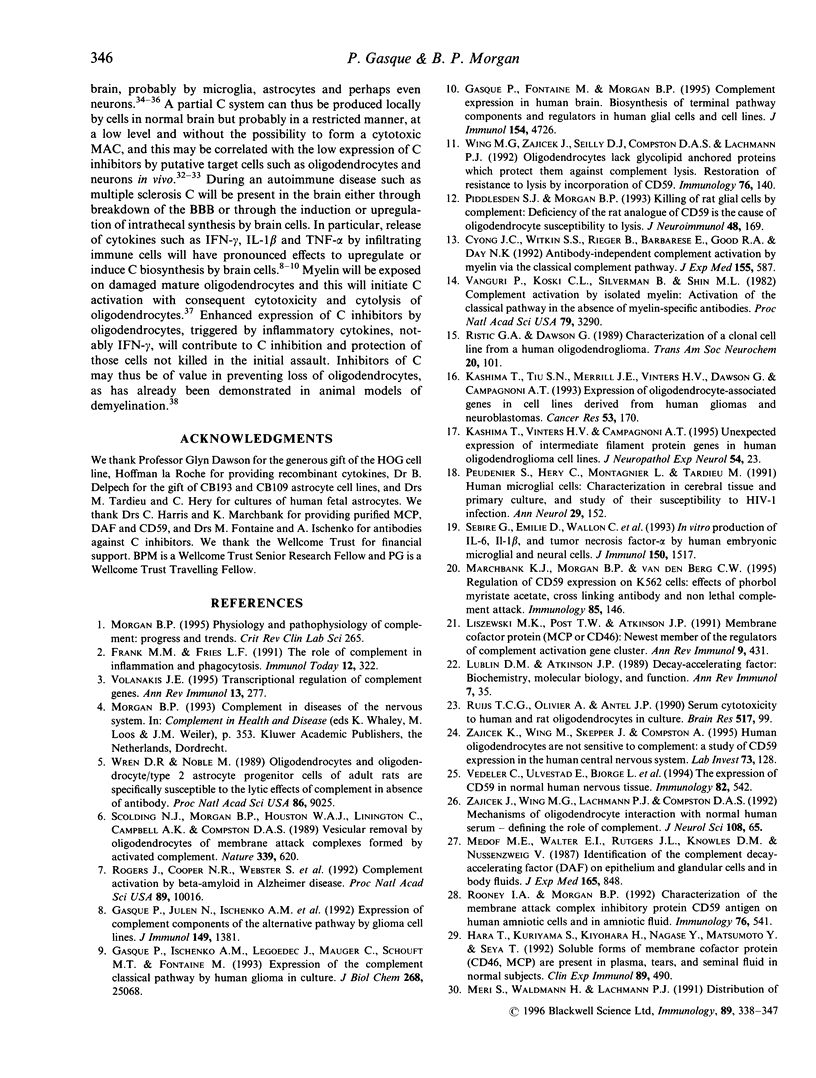
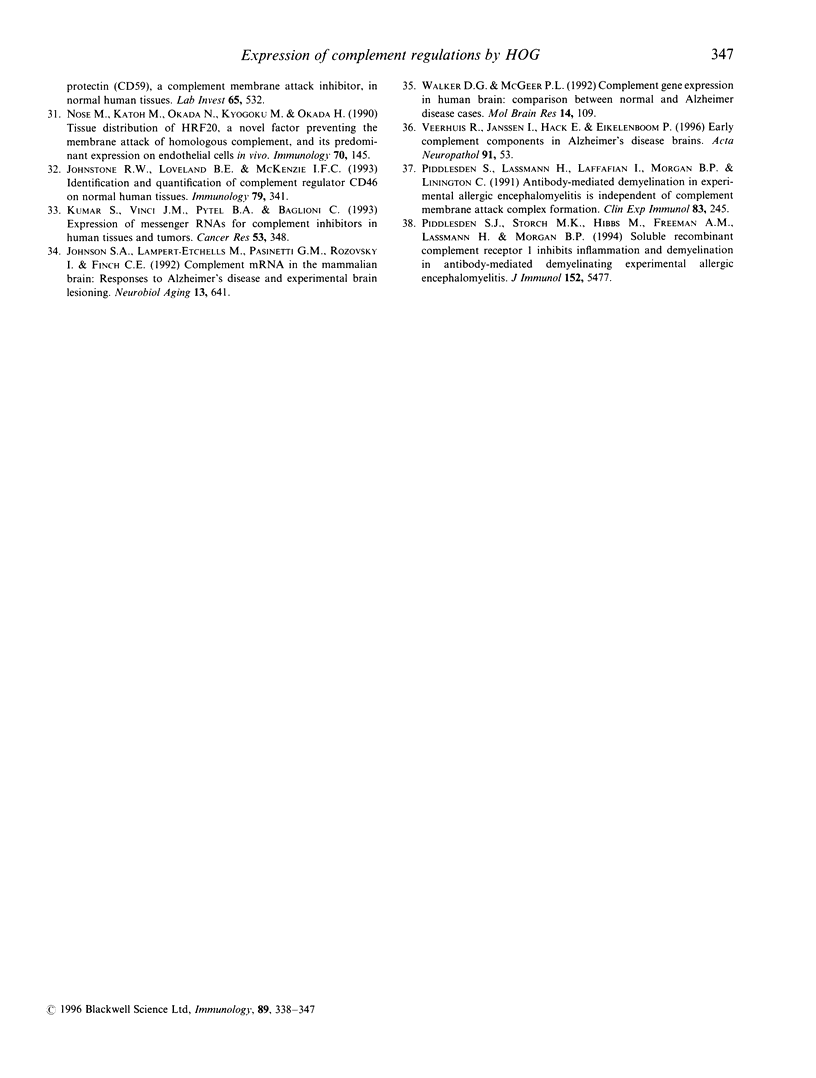
Images in this article
Selected References
These references are in PubMed. This may not be the complete list of references from this article.
- Cyong J. C., Witkin S. S., Rieger B., Barbarese E., Good R. A., Day N. K. Antibody-independent complement activation by myelin via the classical complement pathway. J Exp Med. 1982 Feb 1;155(2):587–598. doi: 10.1084/jem.155.2.587. [DOI] [PMC free article] [PubMed] [Google Scholar]
- Frank M. M., Fries L. F. The role of complement in inflammation and phagocytosis. Immunol Today. 1991 Sep;12(9):322–326. doi: 10.1016/0167-5699(91)90009-I. [DOI] [PubMed] [Google Scholar]
- Gasque P., Fontaine M., Morgan B. P. Complement expression in human brain. Biosynthesis of terminal pathway components and regulators in human glial cells and cell lines. J Immunol. 1995 May 1;154(9):4726–4733. [PubMed] [Google Scholar]
- Gasque P., Ischenko A., Legoedec J., Mauger C., Schouft M. T., Fontaine M. Expression of the complement classical pathway by human glioma in culture. A model for complement expression by nerve cells. J Biol Chem. 1993 Nov 25;268(33):25068–25074. [PubMed] [Google Scholar]
- Gasque P., Julen N., Ischenko A. M., Picot C., Mauger C., Chauzy C., Ripoche J., Fontaine M. Expression of complement components of the alternative pathway by glioma cell lines. J Immunol. 1992 Aug 15;149(4):1381–1387. [PubMed] [Google Scholar]
- Hara T., Kuriyama S., Kiyohara H., Nagase Y., Matsumoto M., Seya T. Soluble forms of membrane cofactor protein (CD46, MCP) are present in plasma, tears, and seminal fluid in normal subjects. Clin Exp Immunol. 1992 Sep;89(3):490–494. doi: 10.1111/j.1365-2249.1992.tb06986.x. [DOI] [PMC free article] [PubMed] [Google Scholar]
- Johnson S. A., Lampert-Etchells M., Pasinetti G. M., Rozovsky I., Finch C. E. Complement mRNA in the mammalian brain: responses to Alzheimer's disease and experimental brain lesioning. Neurobiol Aging. 1992 Nov-Dec;13(6):641–648. doi: 10.1016/0197-4580(92)90086-d. [DOI] [PubMed] [Google Scholar]
- Johnstone R. W., Loveland B. E., McKenzie I. F. Identification and quantification of complement regulator CD46 on normal human tissues. Immunology. 1993 Jul;79(3):341–347. [PMC free article] [PubMed] [Google Scholar]
- Kashima T., Tiu S. N., Merrill J. E., Vinters H. V., Dawson G., Campagnoni A. T. Expression of oligodendrocyte-associated genes in cell lines derived from human gliomas and neuroblastomas. Cancer Res. 1993 Jan 1;53(1):170–175. [PubMed] [Google Scholar]
- Kashima T., Vinters H. V., Campagnoni A. T. Unexpected expression of intermediate filament protein genes in human oligodendroglioma cell lines. J Neuropathol Exp Neurol. 1995 Jan;54(1):23–31. doi: 10.1097/00005072-199501000-00003. [DOI] [PubMed] [Google Scholar]
- Kumar S., Vinci J. M., Pytel B. A., Baglioni C. Expression of messenger RNAs for complement inhibitors in human tissues and tumors. Cancer Res. 1993 Jan 15;53(2):348–353. [PubMed] [Google Scholar]
- Liszewski M. K., Post T. W., Atkinson J. P. Membrane cofactor protein (MCP or CD46): newest member of the regulators of complement activation gene cluster. Annu Rev Immunol. 1991;9:431–455. doi: 10.1146/annurev.iy.09.040191.002243. [DOI] [PubMed] [Google Scholar]
- Lublin D. M., Atkinson J. P. Decay-accelerating factor: biochemistry, molecular biology, and function. Annu Rev Immunol. 1989;7:35–58. doi: 10.1146/annurev.iy.07.040189.000343. [DOI] [PubMed] [Google Scholar]
- Marchbank K. J., Morgan B. P., van den Berg C. W. Regulation of CD59 expression on K562 cells: effects of phorbol myristate acetate, cross-linking antibody and non-lethal complement attack. Immunology. 1995 May;85(1):146–152. [PMC free article] [PubMed] [Google Scholar]
- Medof M. E., Walter E. I., Rutgers J. L., Knowles D. M., Nussenzweig V. Identification of the complement decay-accelerating factor (DAF) on epithelium and glandular cells and in body fluids. J Exp Med. 1987 Mar 1;165(3):848–864. doi: 10.1084/jem.165.3.848. [DOI] [PMC free article] [PubMed] [Google Scholar]
- Morgan B. P. Physiology and pathophysiology of complement: progress and trends. Crit Rev Clin Lab Sci. 1995;32(3):265–298. doi: 10.3109/10408369509084686. [DOI] [PubMed] [Google Scholar]
- Nose M., Katoh M., Okada N., Kyogoku M., Okada H. Tissue distribution of HRF20, a novel factor preventing the membrane attack of homologous complement, and its predominant expression on endothelial cells in vivo. Immunology. 1990 Jun;70(2):145–149. [PMC free article] [PubMed] [Google Scholar]
- Peudenier S., Hery C., Montagnier L., Tardieu M. Human microglial cells: characterization in cerebral tissue and in primary culture, and study of their susceptibility to HIV-1 infection. Ann Neurol. 1991 Feb;29(2):152–161. doi: 10.1002/ana.410290207. [DOI] [PubMed] [Google Scholar]
- Piddlesden S. J., Morgan B. P. Killing of rat glial cells by complement: deficiency of the rat analogue of CD59 is the cause of oligodendrocyte susceptibility to lysis. J Neuroimmunol. 1993 Nov-Dec;48(2):169–175. doi: 10.1016/0165-5728(93)90189-6. [DOI] [PubMed] [Google Scholar]
- Piddlesden S. J., Storch M. K., Hibbs M., Freeman A. M., Lassmann H., Morgan B. P. Soluble recombinant complement receptor 1 inhibits inflammation and demyelination in antibody-mediated demyelinating experimental allergic encephalomyelitis. J Immunol. 1994 Jun 1;152(11):5477–5484. [PubMed] [Google Scholar]
- Piddlesden S., Lassmann H., Laffafian I., Morgan B. P., Linington C. Antibody-mediated demyelination in experimental allergic encephalomyelitis is independent of complement membrane attack complex formation. Clin Exp Immunol. 1991 Feb;83(2):245–250. doi: 10.1111/j.1365-2249.1991.tb05622.x. [DOI] [PMC free article] [PubMed] [Google Scholar]
- Rogers J., Cooper N. R., Webster S., Schultz J., McGeer P. L., Styren S. D., Civin W. H., Brachova L., Bradt B., Ward P. Complement activation by beta-amyloid in Alzheimer disease. Proc Natl Acad Sci U S A. 1992 Nov 1;89(21):10016–10020. doi: 10.1073/pnas.89.21.10016. [DOI] [PMC free article] [PubMed] [Google Scholar]
- Rooney I. A., Morgan B. P. Characterization of the membrane attack complex inhibitory protein CD59 antigen on human amniotic cells and in amniotic fluid. Immunology. 1992 Aug;76(4):541–547. [PMC free article] [PubMed] [Google Scholar]
- Scolding N. J., Morgan B. P., Houston W. A., Linington C., Campbell A. K., Compston D. A. Vesicular removal by oligodendrocytes of membrane attack complexes formed by activated complement. Nature. 1989 Jun 22;339(6226):620–622. doi: 10.1038/339620a0. [DOI] [PubMed] [Google Scholar]
- Sébire G., Emilie D., Wallon C., Héry C., Devergne O., Delfraissy J. F., Galanaud P., Tardieu M. In vitro production of IL-6, IL-1 beta, and tumor necrosis factor-alpha by human embryonic microglial and neural cells. J Immunol. 1993 Feb 15;150(4):1517–1523. [PubMed] [Google Scholar]
- Vanguri P., Koski C. L., Silverman B., Shin M. L. Complement activation by isolated myelin: activation of the classical pathway in the absence of myelin-specific antibodies. Proc Natl Acad Sci U S A. 1982 May;79(10):3290–3294. doi: 10.1073/pnas.79.10.3290. [DOI] [PMC free article] [PubMed] [Google Scholar]
- Vedeler C., Ulvestad E., Bjørge L., Conti G., Williams K., Mørk S., Matre R. The expression of CD59 in normal human nervous tissue. Immunology. 1994 Aug;82(4):542–547. [PMC free article] [PubMed] [Google Scholar]
- Veerhuis R., Janssen I., Hack C. E., Eikelenboom P. Early complement components in Alzheimer's disease brains. Acta Neuropathol. 1996;91(1):53–60. doi: 10.1007/s004019570001. [DOI] [PubMed] [Google Scholar]
- Volanakis J. E. Transcriptional regulation of complement genes. Annu Rev Immunol. 1995;13:277–305. doi: 10.1146/annurev.iy.13.040195.001425. [DOI] [PubMed] [Google Scholar]
- Walker D. G., McGeer P. L. Complement gene expression in human brain: comparison between normal and Alzheimer disease cases. Brain Res Mol Brain Res. 1992 Jun;14(1-2):109–116. doi: 10.1016/0169-328x(92)90017-6. [DOI] [PubMed] [Google Scholar]
- Wing M. G., Zajicek J., Seilly D. J., Compston D. A., Lachmann P. J. Oligodendrocytes lack glycolipid anchored proteins which protect them against complement lysis. Restoration of resistance to lysis by incorporation of CD59. Immunology. 1992 May;76(1):140–145. [PMC free article] [PubMed] [Google Scholar]
- Wren D. R., Noble M. Oligodendrocytes and oligodendrocyte/type-2 astrocyte progenitor cells of adult rats are specifically susceptible to the lytic effects of complement in absence of antibody. Proc Natl Acad Sci U S A. 1989 Nov;86(22):9025–9029. doi: 10.1073/pnas.86.22.9025. [DOI] [PMC free article] [PubMed] [Google Scholar]
- Zajicek J., Wing M. G., Lachmann P. J., Compston D. A. Mechanisms of oligodendrocyte interaction with normal human serum--defining the role of complement. J Neurol Sci. 1992 Mar;108(1):65–72. doi: 10.1016/0022-510x(92)90189-r. [DOI] [PubMed] [Google Scholar]
- Zajicek J., Wing M., Skepper J., Compston A. Human oligodendrocytes are not sensitive to complement. A study of CD59 expression in the human central nervous system. Lab Invest. 1995 Jul;73(1):128–138. [PubMed] [Google Scholar]



